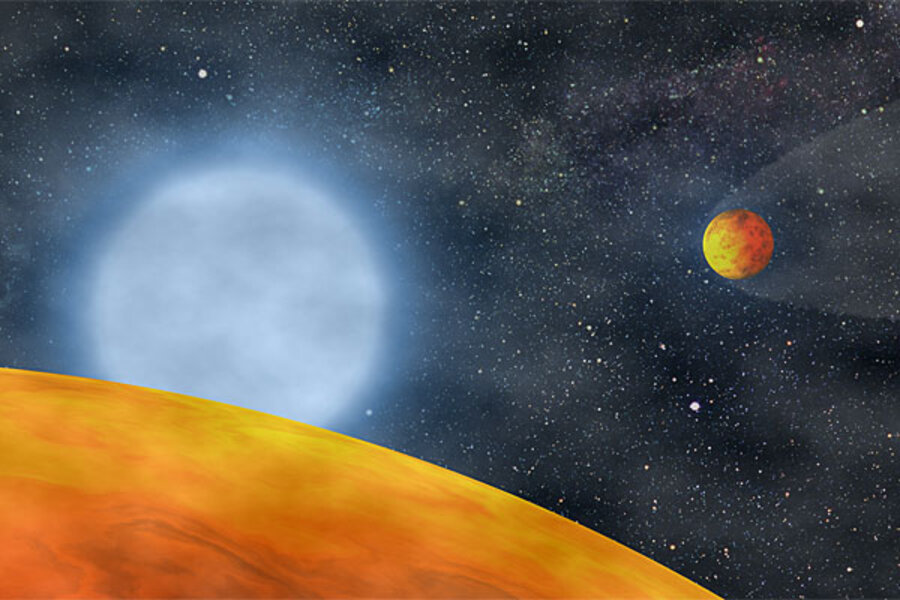What will happen after sun vaporizes Earth? Scorched planets hold clues.
Loading...
Forget this season's final episode of "Survivor." The ultimate survivors appear to be two small planet-candidates engulfed for a billion years inside the searing envelope of a red-giant star. And they emerged to tell the tale.
The planets are a glimpse at what can happen to a solar system when a star begins its death throes, becoming bloated and red as it consumes the last of the hydrogen fuel in its core. The same fate awaits our sun in about 5 billion years.
The two planet-candidates announced Wednesday are among the tiniest yet revealed by data from NASA's planet-hunting Kepler spacecraft. And they hold the potential to shed light not only on how planets could survive such a torching, but also how they might affect the evolution of red-giant stars themselves.
"On many levels, it's very cool," says Elizabeth Green, a researcher with the University of Arizona's Steward Observatory and a member of the team reporting its observations in the Dec. 22 issue of the journal Nature.
A red giant originates as a star roughly like our sun – between 0.5 and 8 times the sun’s mass. As the star exhausts its hydrogen fuel, its core collapses. The heat of that event causes remaining hydrogen in the outer shell to begin fusion, and the star’s outer layer, or photosphere, expands.
By the time the red-giant phase of our sun ends, the Earth, Venus, and Mercury are likely to be vaporized. But scientists have examples of other objects – planets and brown-dwarf stars – that survived being enveloped by red-giant stars they orbited.
None of them, however, is like the ones reported Tuesday. All the previous examples were bigger objects that orbited farther from their parent stars to begin with. For that reason, they didn't spiral as deeply into their stars’ photospheres. When these stars’ red-giant phase ended – and the stars shrank back to become helium-burning so-called subdwarf B stars – the planets survived.
By contrast, the objects reported Tuesday appear to have traveled far deeper into the red-giant's photosphere and survived only as tiny remnants.
Indeed, the planet-candidates orbit so close to their subdwarf B star, named KIC 05807616, that their years are 5.8 hours and 8.2 hours long, respectively. With one side constantly facing the star, the planets’ sun-side faces would roast at between 14,000 and 16,000 degrees Fahrenheit.
So how did the planet-candidates survive such a blistering? The team suggests that the objects may represent the rocky cores of stripped-down gas-giant planets that once orbited farther away.
As KIC 05807616 went through its red-giant phase and expanded, the two planets had to push through far more material as they orbited, creating a drag that slowed them down. That began a long spiral toward the star's core, and as the gas-giant planets migrated, they were stripped of their gas until only the rocky cores remained.
In the process, however, these planets also could have hastened the end of the star's red-giant phase, the team suggests.
The star's gravity is at its weakest in the outer reaches of the extended photosphere. As the planets migrated, their gravity could have stirred the star's outer photosphere in ways that stripped the hot gas away.
There are other possible explanations for the planet-candidates' presence. They could have been rocky planets to start with, were destroyed, and when the red-giant phase ended and the star's photosphere contracted, they reformed from the torched leftovers, says Eliza Kempton, a scientist at the University of California at Santa Cruz, who focuses her research on small extrasolar planets and was not part of the team.
Ironically, the team, which was led by French astronomer Stephane Charpinet of the University of Toulouse, didn't set out to hunt for planets, Dr. Green explains. Instead, the scientists were using Kepler's data to study stars – in particular, stars that had passed through their red-giant phase and had begun to burn the helium in their cores.
KIC 05807616 is one such star. Like many stars, KIC 05807616 varies in brightness in repeating patterns. These patterns can yield information on a star's mass, temperature, size, even the structure of its interior.
Kepler measures such changes with high precision because of the requirements of its planet-hunting mission. It hunts for extrasolar planets by measuring how a planet slightly dims a star's light when passing in front of it. But the scientists using its data need to be able to separate planet-induced dimming from a host star's built-in swings in brightness.
As Dr. Charpinet's team analyzed the varying brightness patterns from KIC 05807616, they detected two additional sets that didn't mesh with the patterns from the star itself.
After carefully weighing other explanations, the most probable explanation left standing was the presence of two planets.
Not everyone is convinced that the team has detected planets, with some ready to go no farther than to describe planet patters as "intriguing modulations." And while the team is confident that the objects are planets, they still formally dub them planet-candidates.
Whatever the answer, astrophysicists studying stars are as tickled to have Kepler on orbit as are planet-hunters. Compared with the tools available prior to Kepler's launch, the quality of the data pouring in from the mission "is fantastic," Green says.





